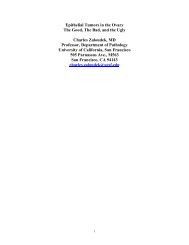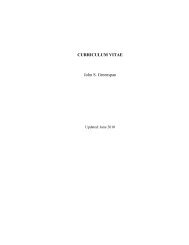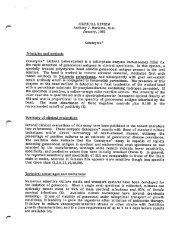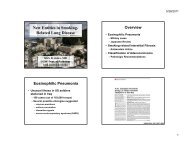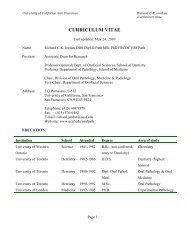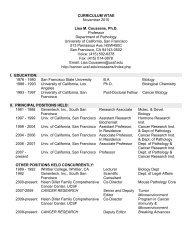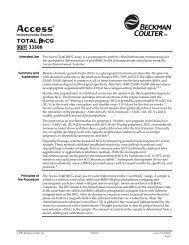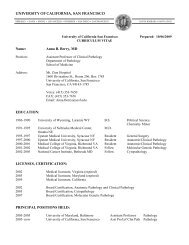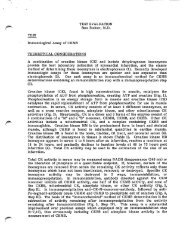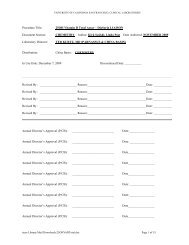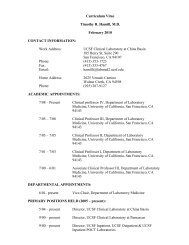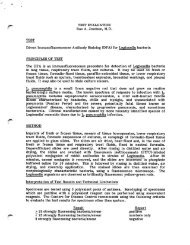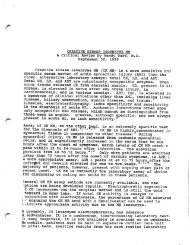Treatment Induced Changes in the Breast: Diagnosis and Staging of ...
Treatment Induced Changes in the Breast: Diagnosis and Staging of ...
Treatment Induced Changes in the Breast: Diagnosis and Staging of ...
Create successful ePaper yourself
Turn your PDF publications into a flip-book with our unique Google optimized e-Paper software.
Recommendation: If <strong>the</strong> pre-treatment tumor was HER2 positive by immunohistochemistry, HER2 can be<br />
used to dist<strong>in</strong>guish residual treated tumor cells from benign mimics (histiocytes, normal epi<strong>the</strong>lium). This<br />
is especially useful when evaluat<strong>in</strong>g marg<strong>in</strong>s or cells with crush artifact.<br />
Evaluat<strong>in</strong>g tumor type follow<strong>in</strong>g NACT<br />
Because <strong>of</strong> <strong>the</strong> cumulative changes to <strong>the</strong> cytoplasm, nuclei, architecture, <strong>and</strong> distribution <strong>of</strong> residual<br />
tumor cells follow<strong>in</strong>g NACT, it may be difficult to assess histologic tumor type. The pre-treatment breast<br />
biopsy is <strong>the</strong> most <strong>in</strong>formative specimen for assess<strong>in</strong>g tumor type. The histiocytoid changes to tumor<br />
cells <strong>and</strong> <strong>the</strong> isolated s<strong>in</strong>gle cell distribution pattern, for example, <strong>in</strong> some residual tumors may mimic<br />
lobular or even pleomorphic lobular differentiation even though <strong>the</strong> pre-treatment core biopsy shows clear<br />
cut ductal differentiation. In <strong>the</strong> NSABP B18 trial, most <strong>of</strong> <strong>the</strong> cases were classified as carc<strong>in</strong>oma NOS<br />
follow<strong>in</strong>g NACT.<br />
Recommendation: Compar<strong>in</strong>g <strong>the</strong> histologic subtype <strong>of</strong> <strong>the</strong> pre-treatment tumor to <strong>the</strong> post-treatment<br />
tumor is good practice, s<strong>in</strong>ce <strong>the</strong> two should be concordant. If <strong>the</strong> post-treatment tumor shows lobular<br />
differentiation, but <strong>the</strong> pre-treatment tumor is ductal, <strong>the</strong> change may be an artifact <strong>of</strong> treatment ra<strong>the</strong>r<br />
than real. E-cadher<strong>in</strong>/p120 immunohistochemistry is advised if <strong>the</strong>re is a discrepancy.<br />
Grad<strong>in</strong>g residual tumor follow<strong>in</strong>g NACT<br />
Because <strong>of</strong> <strong>the</strong> potential cytologic <strong>and</strong> architectural changes <strong>in</strong> tumor follow<strong>in</strong>g NACT, it is reasonable to<br />
raise several questions about traditional tumor grad<strong>in</strong>g if applied to <strong>the</strong> residual tumor:<br />
1.) does NACT cause a significant change before <strong>and</strong> after treatment?<br />
2.) is <strong>the</strong> post treatment grade cl<strong>in</strong>ically valuable (i.e. does it predict survival)?<br />
3.) should a grade be <strong>in</strong>cluded formally <strong>in</strong> <strong>the</strong> surgical pathology report.<br />
Available data with which to address <strong>the</strong>se questions is limited. Frierson et al showed <strong>in</strong> a small study<br />
that pre <strong>and</strong> post treatment grades did not significantly differ but Sharkey et al found changes <strong>in</strong> about a<br />
third <strong>of</strong> patients. Both studies had small numbers <strong>of</strong> patients. Chollet et al tested Scarff-Bloom-<br />
Richardson grad<strong>in</strong>g as well as various comb<strong>in</strong>ations <strong>of</strong> grade with tumor size <strong>and</strong> lymph node status <strong>in</strong><br />
post-treatment specimens; none <strong>of</strong> <strong>the</strong> variables showed any statistically significant relationship with<br />
overall survival, though disease-free survival was related to lymph node status <strong>and</strong> a modified<br />
comb<strong>in</strong>ation <strong>of</strong> tumor size + grade. The best responders to NACT are those with poorly differentiated<br />
tumors where as <strong>the</strong> low grade tumors tend not to respond as well to NACT. This may confound <strong>the</strong><br />
results when look<strong>in</strong>g at outcome <strong>of</strong> post-treatment grad<strong>in</strong>g. Larger scale studies are required with long<br />
follow up.<br />
Recommendation: Our current practice is to note that traditional SBR grad<strong>in</strong>g may not carry <strong>the</strong> same<br />
cl<strong>in</strong>ical significance <strong>in</strong> <strong>the</strong> NACT patient; with this caveat, we do provide a post-treatment tumor grade.<br />
Surgical marg<strong>in</strong> evaluation follow<strong>in</strong>g NACT<br />
Evaluat<strong>in</strong>g marg<strong>in</strong>s can be treacherous because s<strong>in</strong>gle histiocytoid tumor cells may not be seen at low<br />
power. Occult tumor cells are likely to be hidden <strong>in</strong> granulation type tissue, a key visual clue at low<br />
power. The extent <strong>of</strong> occult tumor that is underestimated can be easily appreciated on a kerat<strong>in</strong> sta<strong>in</strong>.<br />
HER2 immunosta<strong>in</strong><strong>in</strong>g is ano<strong>the</strong>r option if <strong>the</strong> pre-treatment tumor was HER2 positive.<br />
Hormone receptor status follow<strong>in</strong>g NACT<br />
Status <strong>of</strong> estrogen receptor (ER), progesterone receptor (PR), <strong>and</strong> Her2/neu is best determ<strong>in</strong>ed on <strong>the</strong><br />
surgical biopsy obta<strong>in</strong>ed prior to NACT because <strong>the</strong> mastectomy/lumpectomy specimen may not conta<strong>in</strong><br />
any or sufficient residual tumor for test<strong>in</strong>g. The status <strong>of</strong> <strong>the</strong>se biomarkers may be altered follow<strong>in</strong>g a<br />
course <strong>of</strong> NACT but is usually concordant with pre-treatment status. The literature conta<strong>in</strong>s only few<br />
studies <strong>of</strong> pre <strong>and</strong> post NACT comparison <strong>of</strong> biomarker status. For ER <strong>and</strong> PR status, studies have<br />
reported changes <strong>in</strong> around 10% <strong>of</strong> cases but some studies document changes <strong>in</strong> up to a third <strong>of</strong> cases;<br />
most commonly, ER status changes from positive to negative. Her2 status appears to be more stable<br />
throughout NACT. Concordance between pre <strong>and</strong> post NACT Her2 status ranges from 65% to 100%.



